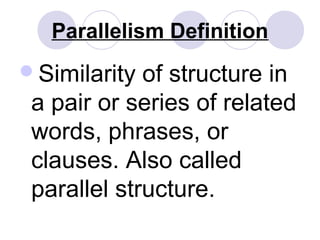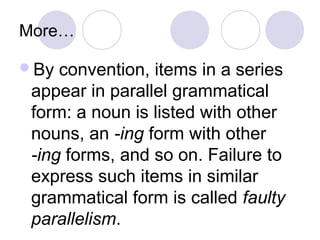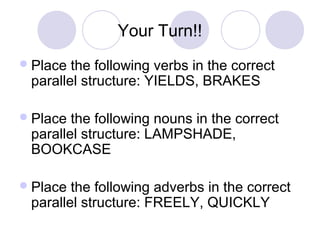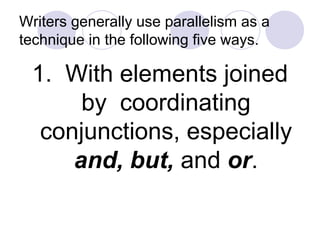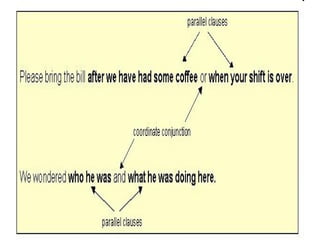Parallelism (1)
- 1. Parallelism
- 2. Parallelism Definition ïŽSimilarity of structure in a pair or series of related words, phrases, or clauses. Also called parallel structure.
- 3. MoreâĶ ïŽBy convention, items in a series appear in parallel grammatical form: a noun is listed with other nouns, an -ing form with other -ing forms, and so on. Failure to express such items in similar grammatical form is called faulty parallelism.
- 4. These Are Good! ï
- 5. These Are Bad! ï
- 6. Before Tom plays the piano. Tom plays the violin.
- 7. After Parallelism = Tom plays the piano and the violin.
- 8. Parallelism with Nouns Jack eats fish and chicken. Sarah writes poetry and short stories.
- 9. Parallelism with Verbs Our neighbors have moved and have sold their house. My sister walks or rides her bike to work.
- 10. Parallelism with Adjectives The class is not only fun but also helpful. She is not only strong but also fast.
- 11. Parallelism with Adverbs Peter drives quickly and aggressively. They work carefully and effectively.
- 12. Your Turn!! ïŽPlace the following verbs in the correct parallel structure: YIELDS, BRAKES ïŽPlace the following nouns in the correct parallel structure: LAMPSHADE, BOOKCASE ïŽPlace the following adverbs in the correct parallel structure: FREELY, QUICKLY
- 13. Writers generally use parallelism as a technique in the following five ways. 1. With elements joined by coordinating conjunctions, especially and, but, and or.
- 16. 2. Use parallel structure with elements in lists or in a series. ïŽ A series is a group of three or more elements in a row. The last element in the series is connected to the others with one of these coordinating conjunctions: and, or, but (not), or yet (not). ïŽ Commas should be placed between each element in the series and before the coordinating conjunction.
- 18. 3. Use parallel structure with elements being compared. (X is more than / better than Y) When we compare things, we often use words such as more, less, better, and worse, We connect the items being compared with words like as and than.
- 20. The elements being compared are parallel to one another: driving is parallel to flying Miriam's ability to is parallel to her resolve to How you live is parallel to how much money you make
- 21. 4. Use parallel structure with elements joined by a linking verb or a verb of being.
- 22. Use parallel structure with elements joined by a correlative conjunction. ïŽThese are the major correlative conjunctions: ïŽ either / or neither / nor both / and not only / but also ïŽ Correlative conjunctions work in pairs.
- 23. Examples with either / or and neither / nor
- 24. Examples with both / and
- 25. Examples with not only / but also
- 26. Parallelism Exercises Rewrite each following sentence to fix all parallelism errors.
- 27. ïŽ1. An actor knows how to memorize his lines and getting into character. ïŽ2. Tell me where you were, what you were doing, and your reasons for doing it. ïŽ3. Clark's daily exercises include running, swimming, and to lift weights.
- 28. ïŽ4. To donate money to the homeless shelter is helping people stay warm in the winter. ïŽ5. Jim not only likes working outside but also getting dirty. ïŽ6. We followed the path through the forest, over the hill, and we went across the river.


